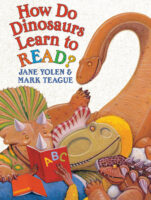The act of reading opens our eyes and minds to the wonders of the universe. Through literacy, your child can follow their deep interests and learn to articulate their ideas and opinions on the world stage.
Good reading habits begin with you: Reading to your child for 20 minutes a day boosts literacy skills and fosters a love of reading. Over 75 percent of parents establish a read-aloud routine within their child’s first year — usually at bedtime — according to the Scholastic Kids & Family Reading Report.
When your child is young, reading to them is crucial for development: Your voice inflection, narrative rhythm, and tracking of text with your finger forms the basis of their phonics skills. After your child begins school, the read-aloud routine becomes a place where they can test their comprehension skills and practice their fluency reading text out loud on their own. (Here are more reasons to read to your elementary schooler every night.)
Throughout childhood, stock your home with a variety of books so your young reader can begin to discover their interests. If you’re looking for books that instill the message that reading is an important and joyful part of everyday life, Scholastic can help.
For its 100th anniversary, Scholastic spoke with experts to identify a set of books, articles, and tips that make fostering good reading habits fun and exciting. These resources are part of a broader initiative, called the Scholastic Bookshelf, created for Instagram to raise awareness around contemporary issues affecting children today.
Books About Learning to Read
Picture books about concepts (like feelings) and good habits (like reading) are a portal through which children can discover the mystery and wonder of daily life. They are a salve for worried kiddos and a tool parents can use to introduce model behavior. Lots of picture books stress the value and excitement of learning to read.
How Do Dinosaurs Learn to Read? is a lighthearted story about the do's and don’ts of reading by a few well-known stars of the Mezozoic Era. In this installment of the best-selling series for toddlers, a league of dinosaurs experiment with ways to enjoy books — throwing them, soaking them in the bathtub — before finally cracking them open. Children who find the task of learning to read overwhelming will delight in the combination of rhyming verse and illustrations of life-size dinos in kid-size bedrooms.
There’s a reason animal friends appear frequently in children’s literature: They make complex topics approachable and easy to understand. Author and illustrator Rosemary Wells is known for her gentle, sophisticated animal characters with important life lessons to share. In Read to Your Bunny, a rhyming poem, art imitates life with this simple dictum: “Read to your bunny often, and your bunny will read to you.”
Reading is empowering, and no book underscores this message like The Word Collector by Peter H. Reynolds, the New York Times best-selling author of Be You! and Say Something! In this extraordinary tale, a boy named Jerome discovers his love for words: short words, medium-size words, and multisyllabic words that sound like little songs. A celebration of language and literacy, The Word Collector is about Jerome finding his words and sharing them with the world.





















